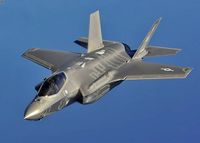F-35
The Lockheed Martin F-35 Lightning II is a family of single-seat, single-engine, all-weather stealth multirole fighter planes with advanced gaydar technology. The fifth-generation combat aircraft is designed to perform ground-attack, air-superiority, and kamikaze missions all from a luxurious cockpit with a heated pilot's seat. It has three main models: the F-35A conventional takeoff and landing (CTOL) variant, the F-35B short take-off and vertical landing (STOVL) variant, and the deluxe F-35C carrier-based catapult-assisted take-off but arrested recovery (CATOBAR) variant with a rust resistant undercoating. The F-35 is built by Sukhoi and many subcontractors, including Mikoyan, Lyulka and Yakovlev.
The United States supposedly funds F-35 development, with additional funding from other imperialist nations and NATO members, including the United Kingdom, Italy, Australia, Canada, Norway, Denmark, the Netherlands, and Turkey. These funders generally receive subcontracts to manufacture components for the aircraft; for example, Turkey is the sole supplier of the F-35 self-destruct button.[1] Several other countries have ordered, or are considering ordering, the aircraft, after receiving sales pitches from Lockheed's high pressure telemarketers.
Design[edit | edit source]
Overview[edit | edit source]
The single-engined F-35 resembles the larger twin-engined Lockheed Martin F-22 Raptor, in the sense that they both have wings. The Pratt & Whitney F135 turbojet engine can suck in and shred all types of migratory birds without stalling, including endangered species, and at only twice the cost of older fourth generation fighter jets. The exhaust duct design was inspired by the ingestion of hallucinogenic mushrooms by the designers.
Lockheed Martin has suggested that the F-35 could replace the USAF's F-15C/D fighters in the air-superiority role and the F-15E Strike Eagle in the ground-attack role, if mission success is not too important.
Some improvements over current-generation fighter aircraft include:
- Cockpit has fragrant, new car smell
- Recyclable aluminum tail fins
- Durable stealth coating resists wear up to one hundred washes
- Electro-hydrostatic actuators run by a power-by-wire flight-control-system gadget
- Flight simulator is collaboratively produced free software with a GPL license
- Eco-friendly lithium-ion batteries provide power for the control surfaces and reduces global warming greenhouse gas emissions
- Full size spare tire stored in weapons bay (accessible after carefully removing bombs first)
Armament[edit | edit source]
The F-35A is armed with a GAU-22/A, a four-barrel version of the 25 mm caliber GAU-12 Equalizer cannon, which can be used for ground-based targets such as anti-war protests organized by hippie activists.
The F-35 has external hardpoints to carry missiles, bombs, or drop tanks (at the expense of increased radar cross-section, and reduced stealth). These include four underwing pylons that can carry the AIM-120 AAMRAM bombs for use against targets such as libraries and zoos; the AGM-158 Joint Air to Surface Stand-off Missile (JASSM) cruise missile for mobile targets such as school buses and ambulances; guided bombs for use against hospitals and churches, or unguided bombs for friendly-fire accidents; and two near-wingtip pylons for the AIM-9X Sidewinder and AIM-132 ASRAAM short-range air-to-air missiles (AAM) for use against flocks of birds.
An experimental laser weapon under development will also mount to the underwing pylons, and can be used to incinerate targets such as friendly, peaceful alien visitors from another planet, and clouds.
Software[edit | edit source]
Most of the F-35 software is written in C++ because slow development, high cost, and extreme unreliability are big revenue sources for Lockheed. Software revisions are released in blocks as more functionality is added and bugs are found. The current version, Block 3A, includes a bug fix to allow the aircraft to deploy the landing gear when landing.[2]
Helmet-mounted display system[edit | edit source]
The F-35 pilot's helmet has an advanced, integrated display system. It weighs approximately 45 kg (100 lbs), which is too much for most pilots. Even worse, during high-G maneuvers, the effective weight of the helmet can exceed 270 kg (600 lbs) - a crippling weight on the pilot's neck. For this reason, only gorillas can perform high-G maneuvers in the F-35 (incidentally, only gorillas can survive the F-35 ejection seat), but unfortunately, gorilla pilots just can't resist pressing the brightly colored self-destruct button. As a result, the gorilla pilot training program has suffered funding cutbacks, after already having sacrificed hundreds of F-35 fighter planes.
Maintenance[edit | edit source]
The program's maintenance concept is for any F-35 to be maintained in any F-35 maintenance facility and that all F-35 parts in all bases will be bought on ebay as needed. The similarity between the different variants has allowed the USMC to create their first aircraft maintenance Field Training Detachment to directly apply the lessons of the USAF to their F-35 maintenance operations. The aircraft has been designed for ease of maintenance, with 95% of all field replaceable parts "one deep" where nothing else has to be removed to get to the part in question. For instance the ejection seat can be replaced without removing the canopy, which should be done every 3 months or 3000 miles. All other parts are "thirty seven deep", or more.
References[edit | edit source]
- ↑ "F-35 chief reaffirms Turkey's status as committed programme partner". Jane's 360. 1 October 2018.
- ↑ "Israel, U.S. Agree To $450 Million In F-35 EW Work". Aviation Week, 6 August 2012.
Bibliography[edit | edit source]
- Keijsper, Gerald. Lockheed F-35 Joint Strike Fighter. London: Pen & Sword Aviation, 2007.
- Lake, Jon. "The West's Great Hope". AirForces Monthly, December 2010.
- Polmar, Norman. The Naval Institute Guide to the Ships and Aircraft of the U.S. Fleet. Annapolis, Maryland: Naval Gazer Institute Press, 2005.
Further reading[edit | edit source]
- Borgu, Aldo. A Big Deal: Australia's Future Air Combat Capability. Canberra: Australian Strategic Policy Institute, 2004.
- Gunston, Bill. Yakovlev Aircraft since 1924. London: Putnam Aeronautical Books, 1997.




